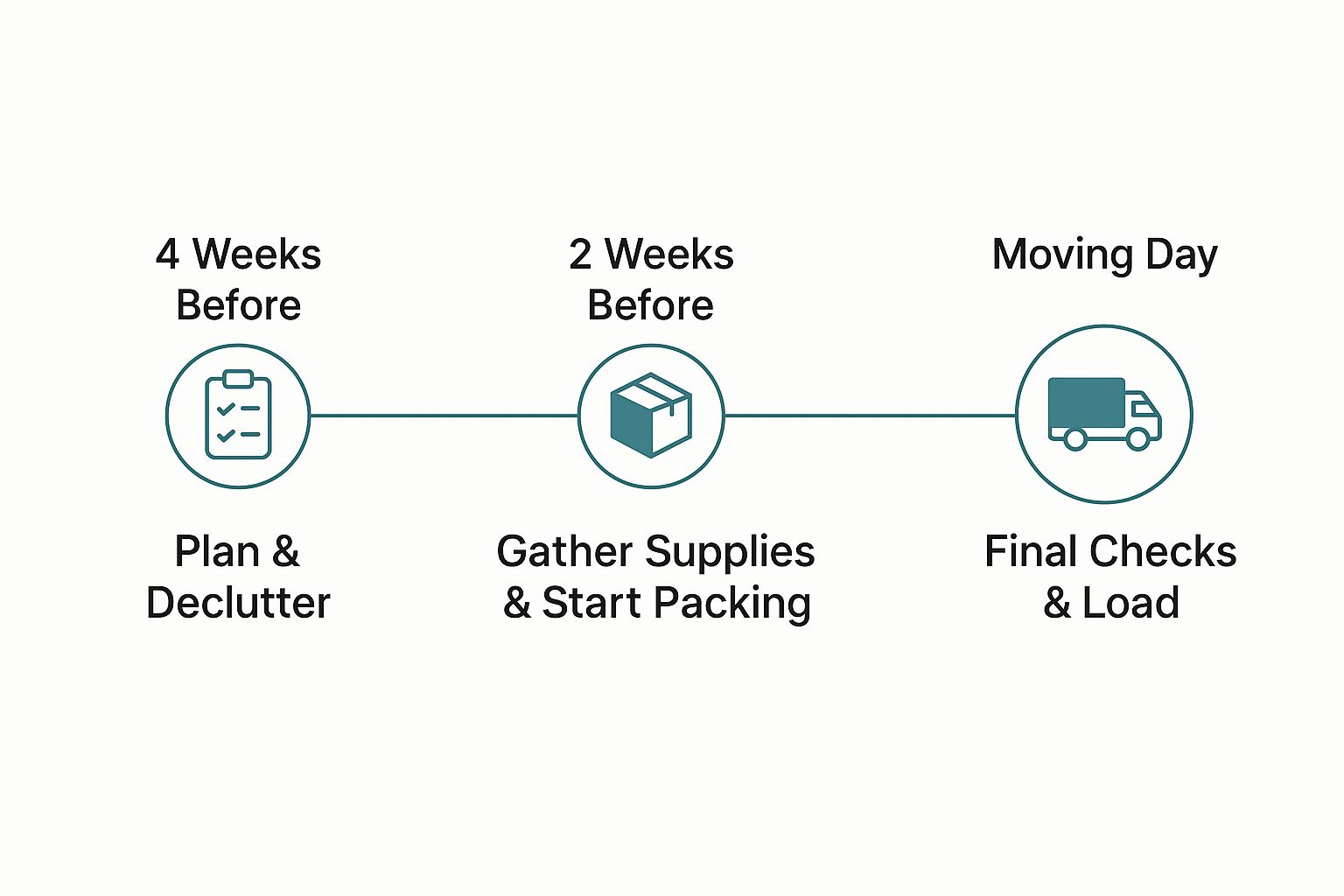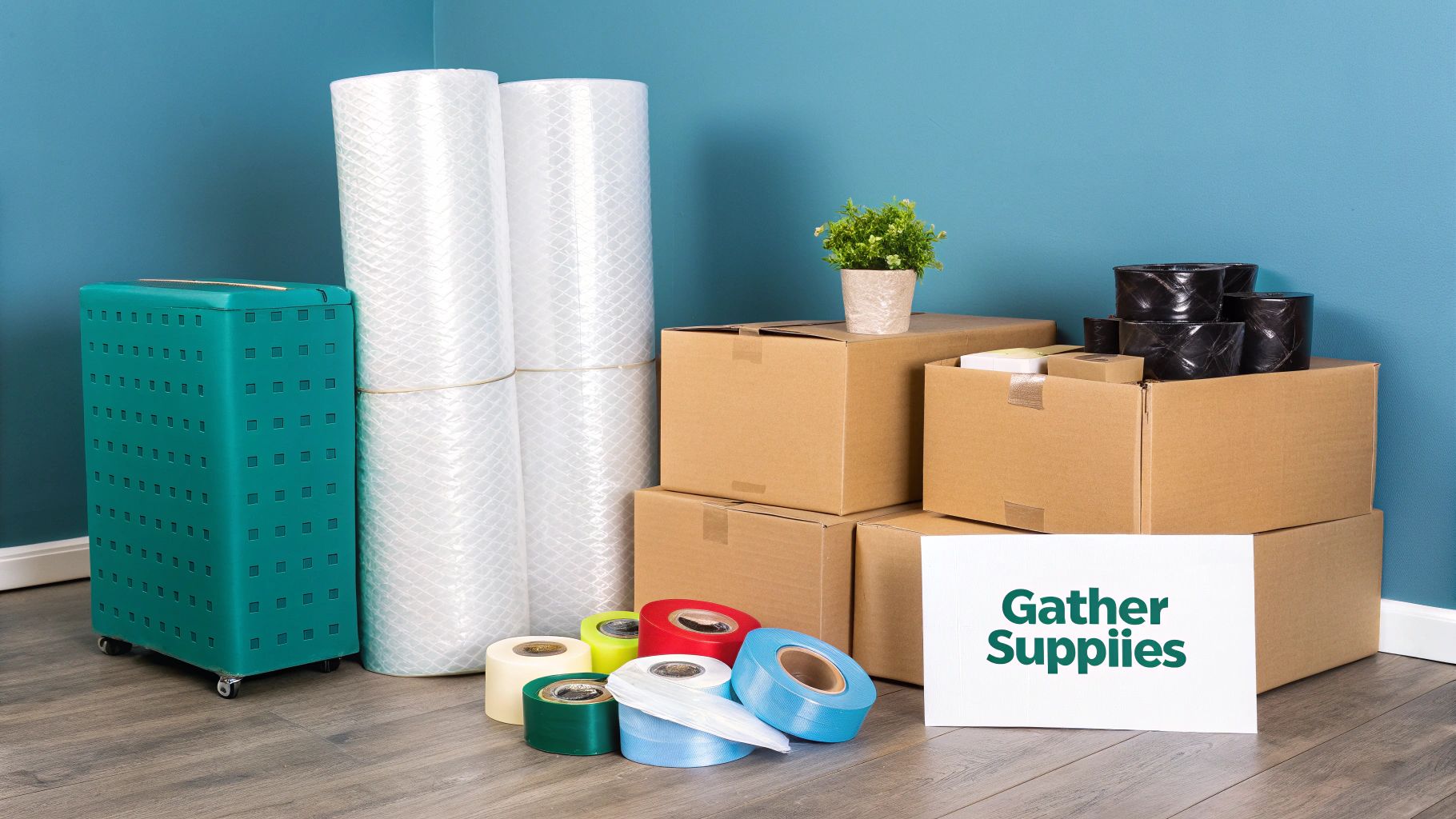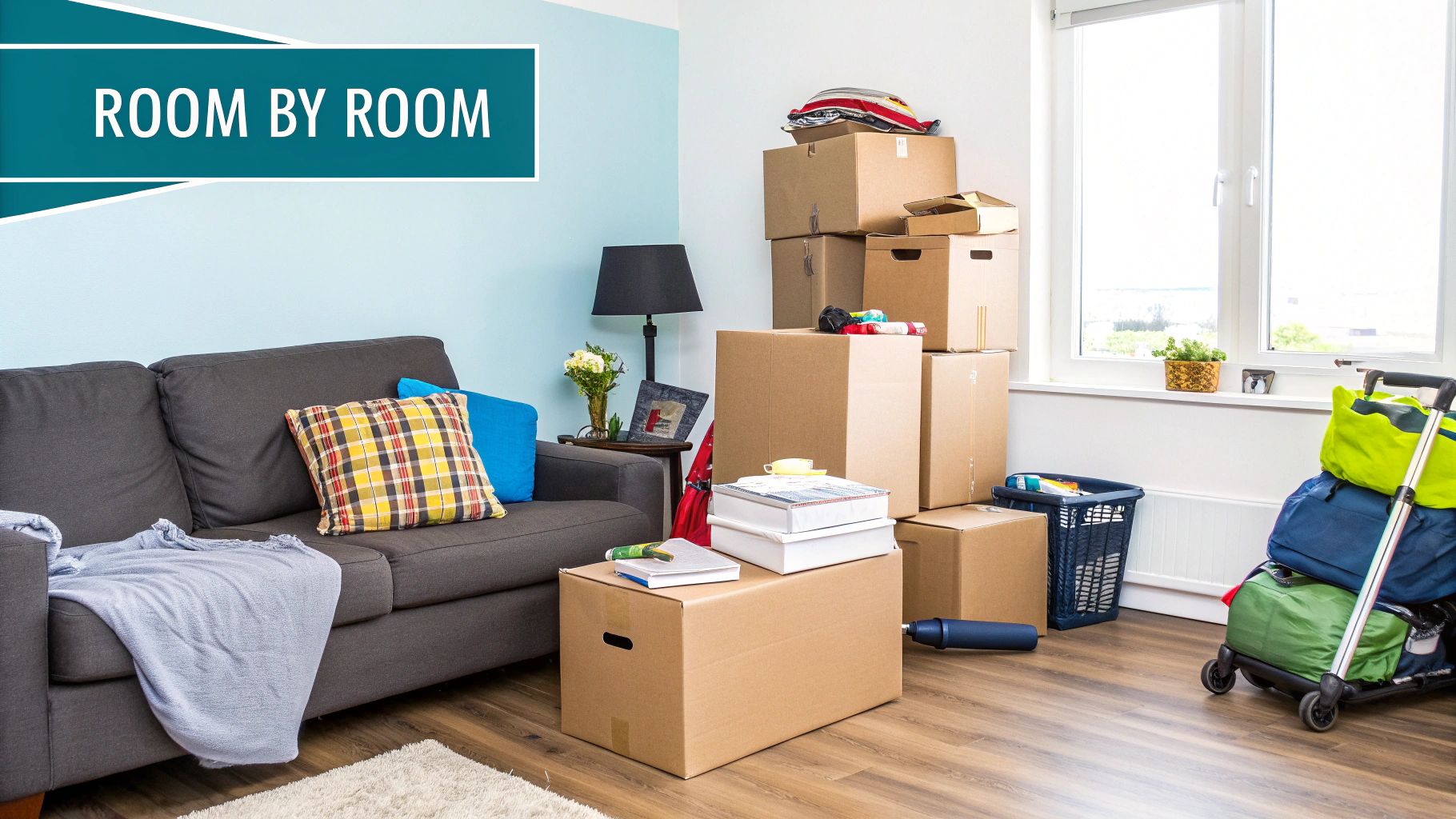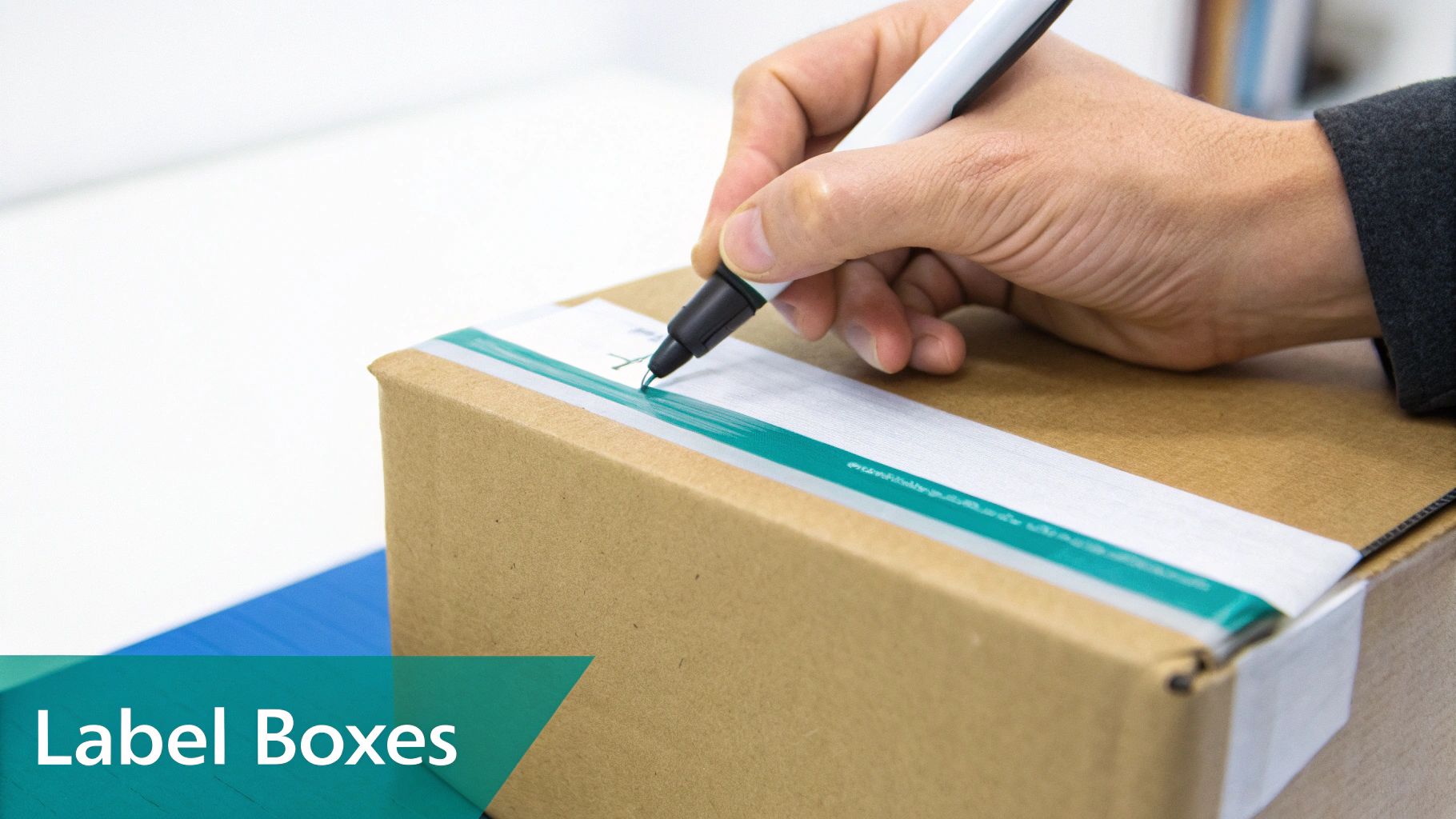Knowing how to pack for a move isn't some dark art. It really just comes down to two things: planning your time and getting the right materials. If you give yourself a solid timeline, starting a few weeks out, what feels like a massive job becomes a series of small, easy wins. Pair that with a proper supply kit, and you're set up to pack everything safely and efficiently right from the start.
Building Your Moving Timeline and Supply Kit
The real secret to a move that doesn't drive you mad isn't about how fast you can chuck things in boxes. It's about having a solid game plan long before you tape up that first box. Success is all about giving yourself enough breathing room to declutter, gather your supplies, and pack in a way that makes sense. Try to wing it, and things get chaotic fast.
A proper plan, kicking off several weeks in advance, turns a last-minute panic into an organised project. It's not just about reducing stress, either. This approach genuinely saves you money by helping you avoid those rushed decisions and overpriced, last-minute supply runs.
Start with Ruthless Decluttering
Before you even think about buying a single roll of tape, you need to decide what’s actually making the journey with you. Moving is the perfect excuse to finally sort through years of stuff you’ve accumulated but don't really need or use anymore. Trust me, moving less is always cheaper and a whole lot easier.
Go through each room and sort everything into three simple piles:
- Keep: The things you love, use all the time, or can't bear to part with.
- Donate/Sell: Anything in good nick that you just don't have a use for anymore.
- Bin: Anything that’s broken, past its sell-by date, or just unusable.
By decluttering first, you could slash the volume of your belongings by as much as 15-20%. That doesn’t just make packing simpler; it could mean you can hire a smaller removal van or need less storage space, which adds up to some serious savings.
If you find you’ve got a fair bit of stuff you want to keep but won't need right away, using a storage calculator can help you estimate the right size unit. It's a great way to stop you from paying for space you simply don't need.
This simple timeline shows how breaking down your move into phases keeps everything organised and on track.

As you can see, dedicating those first few weeks to planning and decluttering builds a crucial foundation for the hands-on packing that comes later.
Gather Your Essential Packing Supplies
Right, so you know exactly what you’re moving. Now it's time to assemble your packing kit. Having everything you need before you start is a game-changer—it stops those frustrating mid-pack dashes to the shops. You'll need more than just a few boxes; quality materials are what will keep your belongings protected.
Here’s a quick-reference guide to all the materials you'll need for a successful and organised move.
Essential Packing Supplies Checklist
| Supply Item | Recommended Quantity (For a 3-Bed House) | Key Purpose |
|---|---|---|
| Small Boxes | 20-25 | Heavy items like books, tools, and kitchenware. |
| Medium Boxes | 30-40 | General household items, toys, and small appliances. |
| Large Boxes | 15-20 | Lighter, bulky items like bedding, cushions, and lampshades. |
| Wardrobe Boxes | 3-5 | Moving clothes on hangers to keep them crease-free. |
| Packing Tape | 8-10 Rolls | Securing boxes. Don't scrimp on this! |
| Bubble Wrap | 2-3 Large Rolls | Protecting fragile items like glassware, mirrors, and artwork. |
| Packing Paper | 1 Large Pack | Wrapping delicate items and filling gaps in boxes. |
| Marker Pens | 3-4 (Different Colours) | Labelling boxes with contents and destination room. |
| Labels/Stickers | 1 Pack (Colour-Coded) | Creating a clear, visual system for organising boxes. |
| Stanley Knife/Box Cutter | 1 | Safely opening boxes upon arrival. |
This checklist should give you a solid starting point, but remember to adjust quantities based on how much stuff you actually have.
Think about sourcing your materials smartly. You can often get leftover boxes for free from local shops or by checking community groups online. But for your fragile or valuable items, it's always worth investing in new, sturdy double-walled boxes. And don't overlook specialised kit like wardrobe boxes—they make moving clothes an absolute breeze. Finally, good quality packing tape is non-negotiable. The cheap stuff just doesn't stick properly, and the last thing you want is a box falling apart at the worst possible moment.
A Practical Room-by-Room Packing Strategy
A logical packing plan does more than just get things into boxes; it’s the secret to a smooth, stress-free unpacking experience later on. By tackling your home room by room in a specific order, you can avoid the classic mistake of packing away essential items far too early. Trust me, this methodical approach is your best defence against last-minute moving day chaos.

The principle is beautifully simple: start with the rooms and items you use the least. This strategy builds momentum and clears out significant space without getting in the way of your daily life. High-traffic areas like the kitchen and master bedroom? Save those for last. That way, your daily essentials are right where you need them, right up until the van arrives.
Start with the Outskirts
Your first targets should be the spaces you rarely set foot in. I’m talking about the loft, cellar, garage, or that spare bedroom that’s become more of a storage unit. These rooms are usually treasure troves of seasonal decorations, old paperwork, and sentimental items that you won’t miss for a few weeks.
Getting these non-essential areas packed first gives you a massive psychological boost. You'll be amazed at how quickly you can clear entire rooms, which creates a real sense of progress right from the start. It’s also the perfect moment for one final declutter—a chance to sort everything into ‘keep’, ‘donate’, or ‘bin’ piles.
If you come across items you want to hang onto but just won't have room for in the new place, don't panic. Setting them aside for flexible self storage is a brilliant move. It means you can move into your new home without immediately filling it with clutter.
Work Towards the Centre
With the least-used areas boxed up, you can gradually work your way towards the heart of your home. This stage usually covers the living room, dining room, home office, and the kids' bedrooms.
Again, start with the things that aren't part of your daily routine.
- Books and Media: Get that book collection, along with any DVDs and video games, boxed up.
- Decorative Items: Ornaments, picture frames, and wall art can all be carefully wrapped and packed away.
- Occasional-Use Crockery: That fancy dinner set you only bring out at Christmas? Now's its time to go.
This is also where you can get a bit creative with your packing materials to save some cash and cut down on waste. Before you buy endless rolls of bubble wrap, take a look at what you already have.
Packing Hack: Use your soft furnishings! Things like towels, jumpers, tea towels, and even socks make for fantastic, free padding. I always wrap delicate glasses in t-shirts and cushion fragile ornaments with bath towels. It offers brilliant protection without costing you an extra penny.
Tackle the High-Traffic Zones Last
The final week before the move is all about the rooms you use every single day: the kitchen, main bedrooms, and bathrooms. These spaces are packed with the essentials you'll need right up to the last minute, so a calm, structured approach here is absolutely vital.
In the kitchen, begin by packing away appliances and gadgets you rarely use—think stand mixers or those specialist baking tins. As moving day gets closer, box up more, leaving out just a handful of plates, mugs, and cutlery for your last couple of meals.
For the bedroom, start with out-of-season clothing and any spare bedding. Vacuum-sealed bags are your best friend here, especially for bulky duvets and winter coats. They can shrink items by up to 75%, which frees up a surprising amount of space in the removal van. Make sure to leave your ‘first night’ essentials unpacked and put them in a clearly marked box you can grab easily.
Nail Your Labelling and Inventory System

A genuinely organised move is built on more than just scribbling 'Kitchen' on a box with a marker. A solid labelling and inventory system is the brain of your entire operation, turning a chaotic pile of brown boxes into a logical, trackable collection of your life's belongings. This is your best defence against lost items and the secret to a calm, controlled unpacking experience.
Without this crucial step, even the most careful packing strategy can unravel quickly. You'll waste precious hours on moving day tearing open boxes just to find the kettle or the bedding for that first night. A smart system tells you—and your removal company—exactly where every single box goes without ever having to peek inside.
Get Smart with a Colour and Number System
From my experience, the most effective methods are always the simplest and most visual. Assigning a specific colour to each room in your new place is a fantastic starting point. This lets anyone helping with the move—friends, family, or professionals—instantly see where a box belongs with just a quick glance. It speeds up the unloading process massively.
Combine this visual cue with a straightforward numbering system, and you've got the makings of a detailed inventory. Here’s how to put this powerful combination into action:
- Assign a Colour: Pick a distinct colour for each room (e.g., blue for the kitchen, green for the master bedroom). Coloured tape or big, bold marker pens work perfectly for this.
- Number Every Box: As you seal each box, give it a unique number. Start with 'Kitchen 1' (or 'K-1'), then move on to 'Kitchen 2', and so on for each room.
- Label on Multiple Sides: This is a pro tip that saves so much hassle. Make sure you write the room, number, and a brief note on the contents on the top and at least two sides of the box. This ensures you can identify it even when it's buried in a stack.
This dual approach is your secret weapon. The colour gives movers instant room identification, while the number links directly back to your detailed inventory list, giving you a complete overview of all your possessions.
Create Your Moving Inventory
Your inventory list is the master document for your entire move. It doesn't need to be fancy; a simple notebook or a spreadsheet on your laptop works just fine. This list is your personal checklist, confirming that everything that left your old home has arrived safely at the new one.
Think of your inventory list as insurance for your peace of mind. It’s the definitive record that helps you track every single box, making it easy to spot if something has gone astray during transit. It also lets you prioritise unpacking, as you’ll know that 'Bedroom 1 – Box 4' contains the essential bedding.
Your list only needs three basic columns: the box number (e.g., 'LR-3'), the destination room (Living Room), and a summary of the contents (e.g., 'Books, photo albums, lamp'). As boxes are unloaded from the van, you can simply tick them off your list. It's a clear and immediate confirmation that everything is accounted for.
Protecting Fragile Valuables and Awkward Items
Some of your belongings need a bit more TLC than just being tossed into a standard box. A huge part of mastering how to pack for a move is knowing the specialist techniques for your most fragile and high-value items. Getting this right is the difference between your grandmother’s china and your new telly arriving in one piece, or… well, pieces.

This attention to detail really is crucial. Here in the UK, the demand for professional moving services, including specialised packing for delicate possessions, proves just how much we value our stuff. In fact, residential moves are expected to hold around 43.7% of the market share in 2025. This figure shows just how much UK residents value the peace of mind that comes with knowing their items are handled correctly. You can get more insights on the UK moving industry and how it's evolving by checking out this market analysis.
Handling Delicate and High-Value Items
When it comes to breakables like glassware, dishes, and ornaments, packing paper and bubble wrap are your best friends. Whatever you do, don't be tempted to use newspaper—the ink can easily transfer and leave stubborn stains on your belongings.
Here’s a simple method I’ve seen work time and time again:
- Wrap Individually: Every single plate, glass, and delicate item deserves its own separate wrapping in packing paper. No exceptions.
- Stack Vertically: This is a pro tip. Plates and bowls are much stronger when stacked on their edges, almost like records in a crate, rather than flat on top of each other.
- Cushion Generously: Before you put anything inside, create a thick bed of scrunched-up paper or bubble wrap at the bottom of the box. Do the same on top, and fill any gaps to stop things from shifting about in transit.
- Mark Clearly: Once sealed, grab a thick marker and label these boxes as 'FRAGILE' and 'THIS WAY UP' on all sides. You can’t overdo it.
For mirrors and artwork, a good layer of bubble wrap is your starting point. The ideal solution is a proper picture or mirror box, but if you don't have one, you can get creative. Just tape several flattened cardboard boxes together to form a custom-fit protector around the item.
The Box-in-a-Box Method for Electronics
Sensitive electronics like laptops, games consoles, or sound systems need extra cushioning to protect them from knocks and bumps. The most effective technique is what we in the business call the 'box-in-a-box' method, which creates a brilliant protective buffer zone.
- Start by wrapping the device securely in a layer of bubble wrap.
- Find a sturdy box that is just slightly larger than the wrapped item. Place it inside and fill any remaining gaps with packing peanuts or scrunched paper so it can’t move an inch.
- Next, choose a larger, heavy-duty box. Line the bottom with a thick layer of cushioning material, then place the smaller box inside.
- Finally, fill all the surrounding space between the inner and outer boxes with more cushioning material before sealing it up securely.
This double-boxing technique is the gold standard for protecting delicate gadgets. It effectively absorbs shocks and vibrations, significantly reducing the risk of damage during the move.
Creative Solutions for Awkward Items
Let's be honest, not everything fits neatly into a square box. For those tricky, awkwardly shaped belongings, you'll need to think outside the box (pun intended).
Take a tall floor lamp. Your best bet is to remove the lampshade and lightbulb and pack them separately. Then, wrap the lamp base and stand in a moving blanket or bubble wrap, securing it well with tape.
Large or delicate houseplants can be a real headache. If you can, try to transport them in your own car. It’s the safest way to avoid them getting crushed or damaged in the back of the van.
Bulky sports equipment like golf clubs or skis? If you have their dedicated travel cases, use them. If not, bubble wrap is your go-to for protecting them from scratches and dents. The main goal here is to cushion any fragile parts and stop them from damaging your other belongings.
Packing Your First Night Essentials Box
After a gruelling day of heavy lifting and directing traffic, the last thing you want is to be rummaging through dozens of boxes just to find a toothbrush or your phone charger. This is where planning your ‘first night box’ becomes an absolute game-changer. Think of it as your personal survival kit for the first 24 hours in your new home.
This one box will make your transition infinitely more comfortable from the moment you step through the door. It should be the last thing loaded onto the removal van and the very first thing you bring inside. A top tip is to mark it with bold lettering or brightly coloured tape, making it impossible to miss in the sea of cardboard.
What to Include in Your Survival Kit
The idea here is simple: pack everything you’ll need to function without having to unpack the entire van. This includes items for personal comfort, a bit of basic cleaning, and of course, a much-needed cuppa. A well-organised essentials box bridges the gap between a chaotic moving day and a settled first evening.
Here’s a checklist I've refined over years of helping people move:
- Personal Items: A comfy change of clothes for everyone, pyjamas, any essential medications, and basic toiletries like toothbrushes, toothpaste, soap, and deodorant.
- Kitchen Basics: A kettle is non-negotiable! Also, mugs, tea bags or instant coffee, sugar, long-life milk, a few spoons, and some snacks. A takeaway menu for a local restaurant is also a brilliant addition.
- Electronics: Phone chargers are a must. A portable power bank can be a lifesaver, along with any other essential cables you'll need right away.
- Cleaning Supplies: A roll of kitchen roll, a multi-surface cleaning spray, bin bags, and washing-up liquid. You'll be grateful for these when you want to give the kitchen counters a quick wipe-down before you order that pizza.
- Tools and Essentials: A Stanley knife for tackling the other boxes, a small first-aid kit, toilet roll, and maybe a torch, just in case.
This box is your immediate comfort and convenience hub. Taking 30 minutes to pack it thoughtfully is an investment in a calm and restorative first night, allowing you to recharge before you face the big unpack the next day.
This approach of creating dedicated, purpose-driven boxes isn't just for home moves. Businesses can learn a lot from this method; check out our guide on essential tips for maximising business storage space for more organisational strategies. By treating your essentials box with this level of importance, you’re not just packing; you’re planning for a successful move from the get-go.
Knowing When to Hire Professional Packers
Let’s be honest, packing is a monumental task. While many of us roll up our sleeves and tackle it ourselves, there are times when calling in the professionals is genuinely the smartest move you can make. It’s not about being lazy; it's a strategic decision based on your schedule, the size of your move, and what you’re moving. For many, it's a worthwhile investment in a much calmer moving experience.
The most common trigger? Realising you’ve run out of time. If you’re juggling work commitments or facing a tight completion date on your property, the sheer speed of a professional crew can be a lifesaver. They can pack an entire house in a day or two—a job that could easily take one person weeks.
Evaluating the Benefits of Professional Help
Speed is a huge plus, but the real value of hiring packers lies in their expertise. These teams are trained to protect everything from your everyday crockery to that antique vase you inherited, and they show up with professional-grade materials that offer far better protection than what you'd find at a local shop.
Think about these key advantages:
- Sheer Efficiency: A trained team works systematically, clearing rooms with a speed and organisation that’s almost impossible to replicate on your own.
- The Right Gear: They arrive with everything—double-walled boxes, specialised wrapping for furniture, and the proper cushioning for all your delicate items.
- Insurance Cover: Reputable removal companies provide insurance. This gives you crucial financial protection and peace of mind, just in case something gets damaged along the way.
- Less Stress: Handing over the most physically draining part of the move frees you up to focus on everything else, from redirecting your post to saying goodbye to the neighbours.
The UK's Removal Services industry is a serious business, projected to be worth £1.2 billion by 2025. The leading firms set high standards, often bundling services like packing and storage into a complete package for their customers. You can explore insights on the UK removal services market to get a better sense of the industry.
Customising the Service to Your Needs
Hiring packers doesn’t have to be an all-or-nothing deal. Most UK removal companies offer flexible services, letting you get help exactly where you need it most. This makes professional help far more accessible and affordable than you might think.
You can often choose from a few different options:
- Full Packing Service: The team packs every single thing in your home. They bring all the materials and do all the work. It’s the ultimate hands-off option.
- Fragile-Only Service: You handle the sturdy stuff like books and clothes, and the professionals take care of the breakables—kitchenware, glass, mirrors, and artwork.
- Part-Pack Service: You can ask them to pack specific rooms. The kitchen is a popular choice, as it’s often the most time-consuming and fiddly room to sort out.
Deciding whether to hire professionals often comes down to a simple cost-benefit analysis. Weigh up the value of your time, the potential cost of replacing damaged items, and the price of your own sanity against the company's quote. For large homes or moves involving valuable collections, the investment almost always pays for itself.
If you opt for a partial packing service, you might still need a temporary home for the boxes you're packing yourself. Learning how to choose the best storage facility when moving house can be a huge help, giving you the space to declutter and pack at your own pace.
Got Questions About Packing and Moving? We’ve Got Answers.
Every move throws up its own set of questions. As you get closer to the big day, you’ll find certain worries and queries popping up again and again. We’ve been there, so we’ve gathered the most common ones here to give you clear, straightforward answers to help you handle those final details with confidence.
How Can I Save Money on Packing Materials?
Keeping costs down is a huge priority for most people moving house. Thankfully, there are plenty of clever ways to cut your spending on packing supplies without risking your belongings.
- Ask local shops: Supermarkets, off-licences, and especially bookshops often have sturdy cardboard boxes they're more than happy to give away. It never hurts to pop in and ask.
- Use what you already own: Don't underestimate the packing power of your own stuff. Towels, jumpers, bedding, and even socks make for brilliant, free padding for fragile items.
- Check online communities: Websites like Freecycle or local social media groups are fantastic for finding people giving away their used (but still perfectly good) moving boxes.
What Is the Hardest Room to Pack?
In our experience, the kitchen is almost always the toughest room to tackle. It's a tricky combination of heavy, awkwardly shaped, and incredibly fragile items, all jumbled together. One minute you're dealing with sharp knives and bulky appliances, the next it's delicate glassware and countless tiny utensils.
The kitchen is also the room you use right up until the last minute, making the timing of the pack particularly difficult. Our best advice is to start early with non-essentials and leave just a core "survival kit" for your final few days.
How Do I Decide What to Do with Items I Can't Take?
Once you’ve had a good declutter, you'll probably have a pile of things you no longer need but are too good to just throw away. Knowing how to handle them responsibly is key.
Start by sorting everything into three piles: to sell, to donate, and to recycle. Car boot sales or online marketplaces are great for selling more valuable pieces. For everything else, local charity shops are always grateful for good-quality donations of clothes, books, and household goods. For old electronics or large items that can't be donated, check your local council's website for their specific recycling and bulk waste collection services.
Our Top Tip: Figure out what you're doing with unwanted items well in advance to avoid a last-minute panic. Schedule donation drop-offs or council collections a week or two before your move. It ensures everything is handled smoothly and you’re not left with things you can't take with you.
Feeling swamped by the sheer volume of stuff you need to pack or store? Shield Self Storage offers a simple, secure solution. Whether you need a temporary space while you declutter or a longer-term home for items that won't fit in your new place, we have the perfect unit for you.
Find your ideal storage unit with Shield Self Storage today!



